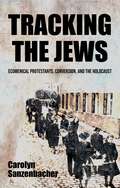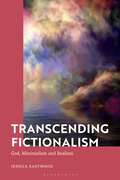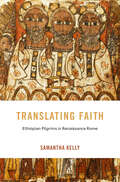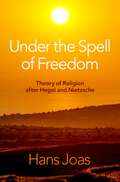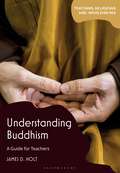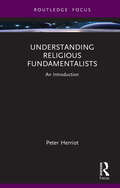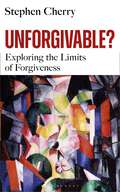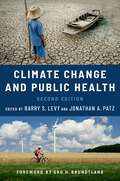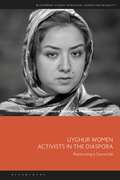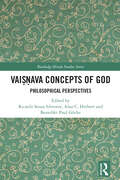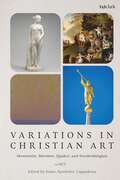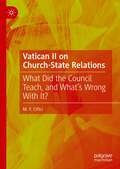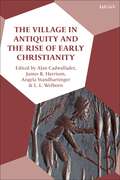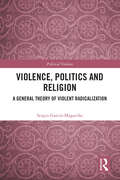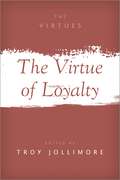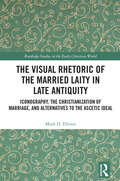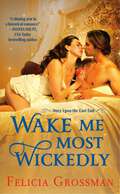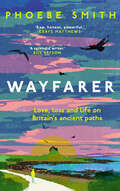- Table View
- List View
Tracking the Jews: Ecumenical Protestants, Conversion, and the Holocaust
by Carolyn SanzenbacherTracking the Jews analyses the beliefs, ideas, concepts, arguments and policies of an unprecedented conversionary initiative during the years immediately before, during and after the Holocaust.From the rubbles of World War I to the ashes of World War II, it reconstructs previously unknown relations between a Protestant framework for global evangelisation of Jews, the network of international bodies that constituted the ecumenical movement of the early twentieth century, and the streams of thought on the Jewish question that flowed through its networking channels.Based on more than twenty thousand pages of archival documents, it forces from the shadows the conversionary issues in which nineteen centuries of negative Church teachings on Jews were rooted, bringing to light a field of transnationally shared beliefs about the place, role and destiny of Jews in world society. It sets into sobering relief the paradoxical ways in which a broad international toleration of traditional anti-Judaism allowed, under a banner of Christian benevolence, a transnational public discourse of antisemitic ideas masked in conversionary language.
Transcending Fictionalism: God, Minimalism and Realism
by Dr Jessica EastwoodExploring alternative conceptions of the divine, Jessica Eastwood considers the ways of believing in God that are authentic and sincere, moving beyond traditional metaphysical structures that many find difficult to accept. In this study, she examines a unique branch of religious non-realism known as religious fictionalism, making the case for its ability to resonate on an intellectual and emotional level. Considering the extent to which fictionalism allows us to make sense of the role of religion in our spiritual lives, she presents its limitations on adhering to what might be an attractive contemporary model for philosophy of religion called 'the humane turn'.Articulating an alternative conception of God that we can relate to in an intellectual, emotional and spiritual way, Eastwood sheds light on a minimalist form of religious realism, which preserves the reality of God without committing the theist to a host of additional religious beliefs.
Translating Faith: Ethiopian Pilgrims in Renaissance Rome (I Tatti Studies in Italian Renaissance History)
by Samantha KellyA revealing account of the lives and work of Ethiopian Orthodox pilgrims in sixteenth-century Rome, examining how this African diasporic community navigated the challenges of religious pluralism in the capital of Latin Christianity.Tucked behind the apse of Saint Peter’s Basilica in Rome is the ancient church of Santo Stefano. During the sixteenth century, Santo Stefano hosted an unusual community: a group of Ethiopian Orthodox pilgrims whose faith and culture were both like and unlike those of Latin Europe. The pilgrims of Santo Stefano were the only African community in premodern Europe to leave extensive documents in their own language (Gǝʿǝz). They also frequently collaborated with Latin Christians to disseminate their expert knowledge of Ethiopia and Ethiopian Christianity, negotiating the era’s heated debates over the boundaries of religious belonging.Translating Faith is the first book-length study of this community in nearly a century. Drawing on Gǝʿǝz and European-language sources, Samantha Kelly documents how pilgrims maintained Ethiopian Orthodox practices while adapting to a society increasingly committed to Catholic conformity. Focusing especially on the pilgrims’ scholarly collaborations, Kelly shows how they came to produce and share Ethiopian knowledge—as well as how Latin Christian assumptions and priorities transformed that knowledge in unexpected ways. The ambivalent legacies of these exchanges linger today in the European tradition of Ethiopian Studies, which Santo Stefano is credited with founding.Kelly’s account of the Santo Stefano pilgrim community is a rich tale about the possibilities and pitfalls of ecumenical dialogue, as well as a timely history in our own age marked by intensive and often violent negotiations of religious and racial difference.
Under the Spell of Freedom: Theory of Religion after Hegel and Nietzsche
by Hans JoasHow do the history of religion and the history of political freedom relate to each other? The variety of views on this subject in philosophy, the humanities and social sciences, and the public is broad and confusing. But the grandiose synthesis in which Hegel brought together Christianity and political freedom is still an enormous source of orientation for many-despite or even because of the influential provocations of Friedrich Nietzsche. As Hans Joas shows in Under the Spell of Freedom, a different view has developed in the religious thinking of the twentieth century based on a conception of history that is more open to the future and on a concept of freedom that is richer than that of Hegel. Using sixteen selected thinkers, Joas deconstructs the grand Hegelian narrative of human history as the self-realization of the idea of freedom, setting as a counterpart the sketches of a theory of the emergence of moral universalism. Further, taking the classical views of Hegel and his emphasis on the role of Protestant Christianity and the extremely negative views about Christianity in the work of the philosopher Friedrich Nietzsche, Joas elaborates on this new understanding of religion and freedom, which avoids both Eurocentrism and an intellectualist view of religious faith and practice. The result is a forceful plea for a global history of moral universalism. Under the Spell of Freedom is an important step in this direction.
Understanding Buddhism: A Guide for Teachers (Teaching Religions and Worldviews)
by James D. HoltBuddhism is often the religion that teachers have the least confidence in teaching despite being the sixth largest religion in the UK and being commonly regarded as one of the six major religions to be taught in schools throughout the country. This book explores the beliefs and practices of Buddhism as a lived religion in the UK. This book engages with Buddhist beliefs and practices and provides students and teachers with the confidence to address misconceptions and recognise the importance of beliefs in the lives of believers, in a way that will enable readers to go forward with confidence. Aspects of Buddhism explored include the concepts that form the central beliefs of Buddhism, and then the expression of these beliefs in worship, daily life, and the ethics of Buddhists in the modern day. Each chapter includes authentic voices of believers today and provides opportunities for the reader to consider the concepts and how they can be respected and taught and in the classroom.The book forms part of the Teaching Religions and Worldviews series of guides, each one designed to build teachers' confidence and expertise in teaching a different religion or worldview in the classroom..
Understanding Religious Fundamentalists: An Introduction (Routledge Focus on Religion)
by Peter HerriotThis book introduces the prominent role that fundamentalists play in religious, cultural, and political arenas.It begins by investigating religious fundamentalist groups and their psychological motivations for this counter-cultural adherence. Their extremely varied actions, argues the author, are based on two fundamental beliefs: that God speaks to them personally through his Word; and that they are involved in a cosmic war between God and Satan.. Subsequent chapters explore how fundamentalisms meet universal psychological needs for meaning, identity, agency, and self-esteem. Moving from individual psychology to social context, the latter half of the book explores how fundamentalist movements derive and exercise their authority and how leaders may strategise to appeal to external societies. The closing chapters seek to place the growth of fundamentalisms and their continued popularity in the social context of modernity and populism.With engaging discussion questions and suggestions for further reading, this book is ideal for students of social science and religion, as well as readers interested in the psychological roots of fundamentalism.
Understanding Religious Fundamentalists: An Introduction (Routledge Focus on Religion)
by Peter HerriotThis book introduces the prominent role that fundamentalists play in religious, cultural, and political arenas.It begins by investigating religious fundamentalist groups and their psychological motivations for this counter-cultural adherence. Their extremely varied actions, argues the author, are based on two fundamental beliefs: that God speaks to them personally through his Word; and that they are involved in a cosmic war between God and Satan.. Subsequent chapters explore how fundamentalisms meet universal psychological needs for meaning, identity, agency, and self-esteem. Moving from individual psychology to social context, the latter half of the book explores how fundamentalist movements derive and exercise their authority and how leaders may strategise to appeal to external societies. The closing chapters seek to place the growth of fundamentalisms and their continued popularity in the social context of modernity and populism.With engaging discussion questions and suggestions for further reading, this book is ideal for students of social science and religion, as well as readers interested in the psychological roots of fundamentalism.
Unforgivable?: Exploring the Limits of Forgiveness
by Stephen CherryForgiveness is a lovely idea, wrote C. S. Lewis, and in recent decades it has been seen and admired in situations ranging from therapy to politics, and proposed as a constructive pathway in the aftermath of abuse and atrocity. Not everyone is impressed, however, and in parallel with praise and promotion of forgiveness, cries of 'unforgivable' are uttered with increased shrillness and frequency. In this hugely compelling, wide-ranging, and thought-provoking book, Stephen Cherry argues that while forgiveness can be transformative in the aftermath of harm, it can also, if not handled with care, become an additional pressure and anxiety for those who have been harmed. He teases out the way in which Christian understandings often lie behind pressure to forgive, identifying a number of typical mistakes with the Christian approach to forgiveness. Reflecting on many examples from real life as well as literature, and on the insights of psychologists and philosophers, Cherry uses the tension between the desire to forgive and the protest that a person is unforgivable to push towards understandings of forgiveness that avoid the harshness of binary models. Forgiveness is not, he insists, the only good way forward after harm. A positive understanding of non-vengeful unforgiveness is vital if the harmed are to be given the care and support they need and deserve, and if forgiveness itself is to be authentic and liberating. Cherry's challenging book brims with energy and blends human insight with intellectual vision. It argues that if forgiveness is to play a part in the aftermath of harm without inflicting further harm it must be presented in a non-idealized way and only following acknowledgement of the depth of the human impact of the harm done.
The Unknown God: W. T. Smith and the Thelemites (Oxford Studies in Western Esotericism)
by Martin P. StarrThe Unknown God is the first documentary study of Thelema, a twentieth-century religious movement in the "magical" family, founded by the occultist, poet, and prophet of a new age of personal freedom, Aleister Crowley (1875--1947). Martin P. Starr tells the history of the movement through the biography of its leader, Wilfred Talbot Smith (1885--1957), who took up Crowley's plans for organizations to teach the latter's methods in Western and Eastern esoteric traditions and his laws for a new world order, and established these systems in British Columbia and in California. Crowley provided the concepts; Smith and his associates made them take flesh, applying Crowley's doctrine of "Do what thou wilt" and cementing it a part of the artistic and religious underground of the twentieth century. This account provides a contextual overview of the elements of the resulting bricolage of religions, which included Freemasonry, Theosophy, Rosicrucianism, Neo-Gnosticism and other related forms of esotericism, demonstrating the overlap between apparently disparate ideologies, groups, and participants. Drawing primarily on diaries and letters, Starr gives a rare and fascinating study of the contemporaneous application of Crowley's thought, whose long trail we can see in the Satanism of Anton LaVey, the Scientology of L. Ron Hubbard, and the popularization of many forms of witchcraft, magic, and tantric practices.
Uyghur Women Activists in the Diaspora: Restorying a Genocide (Bloomsbury Studies in Religion, Gender, and Sexuality)
by Susan J. Palmer Dilmurat Mahmut Abdulmuqtedir UdunPresenting the life stories of ten Uyghur women, this book applies the techniques of narrative analysis to explore their changing worldviews and conversions to political engagement. Born and raised in East Turkestan/Xinjiang in the 1970s-90s, each woman, after personally experiencing incidents of ethnic discrimination, chose to leave China before 2005. Settling in a western country, they strive to become the voice of the Turkic people who are silenced or detained in the “re-education” camps.The narratives are based on interviews conducted online between 2020 and 2021, collected as a form of oral history. The book focuses on the escalating tensions, turning points experienced in their youth, and the religious, political and psychological factors that prompted their transformations in self-identity, ideology and the emergence of a new Uyghur–Muslim feminism.Through the women's stories, the book describes how women activists are navigating the competing reality constructions of the dire situation in the Uyghur Homeland and actively restorying a genocide to bring about social and political change.
Vaiṣṇava Concepts of God: Philosophical Perspectives (Routledge Hindu Studies Series)
This book explores a number of concepts of God in Vaiṣṇavism, which is commonly referred to as one of the great Hindu monotheistic traditions. By addressing the question of what attributes God possesses according to particular Vaiṣṇava textual sources and traditions, the book locates these concepts within a global philosophical framework. The book is divided into two parts. The first part, God in Vaiṣṇava Texts, deals with concepts of God found in some of the more prominent canonical Vaiṣṇava texts: the Bhagavad-Gītā, the Bhagavata-Purāṇa, the Jayākhya-Saṃhitā as representative of the Pāñcarātras, and the Mahābhārata. The second part, God in Vaiṣṇava Traditions, addresses concepts of God found in several Vaiṣṇava traditions and their respective key theologians. In addition to the Āḻvārs, the five traditional Vaiṣṇava schools—the Śrī Vaiṣṇava tradition, the Madhva tradition, the Nimbārka tradition, the Puṣṭimārga tradition, and the Caitanya Vaiṣṇava tradition—and two contemporary ones—those of Ramakrishna (who has Vaiṣṇava leanings) and Swami Bhaktivedanta—are considered. The book combines normative, critical, and descriptive elements. Some chapters are philosophical in nature, and others are more descriptive. Each unpacks a specific Vaiṣṇava concept of God for future philosophical analysis and critique. Written by experts who break new ground in this presentation and representation of the diversity of Vaiṣṇava texts and traditions, the book provides approaches that reflect the amount of philosophical and historical deliberation on the specific issues and divine attributes so far considered in the field of Hindu Studies. This book will be of interest to researchers in disciplines including philosophy of religion and Indian philosophy, cross-cultural and comparative philosophy, analytic philosophy of religion, Hindu Studies, theology, and religious studies.
Vaiṣṇava Concepts of God: Philosophical Perspectives (Routledge Hindu Studies Series)
by Ricardo Sousa Silvestre Alan C. Herbert Benedikt Paul GöckeThis book explores a number of concepts of God in Vaiṣṇavism, which is commonly referred to as one of the great Hindu monotheistic traditions. By addressing the question of what attributes God possesses according to particular Vaiṣṇava textual sources and traditions, the book locates these concepts within a global philosophical framework. The book is divided into two parts. The first part, God in Vaiṣṇava Texts, deals with concepts of God found in some of the more prominent canonical Vaiṣṇava texts: the Bhagavad-Gītā, the Bhagavata-Purāṇa, the Jayākhya-Saṃhitā as representative of the Pāñcarātras, and the Mahābhārata. The second part, God in Vaiṣṇava Traditions, addresses concepts of God found in several Vaiṣṇava traditions and their respective key theologians. In addition to the Āḻvārs, the five traditional Vaiṣṇava schools—the Śrī Vaiṣṇava tradition, the Madhva tradition, the Nimbārka tradition, the Puṣṭimārga tradition, and the Caitanya Vaiṣṇava tradition—and two contemporary ones—those of Ramakrishna (who has Vaiṣṇava leanings) and Swami Bhaktivedanta—are considered. The book combines normative, critical, and descriptive elements. Some chapters are philosophical in nature, and others are more descriptive. Each unpacks a specific Vaiṣṇava concept of God for future philosophical analysis and critique. Written by experts who break new ground in this presentation and representation of the diversity of Vaiṣṇava texts and traditions, the book provides approaches that reflect the amount of philosophical and historical deliberation on the specific issues and divine attributes so far considered in the field of Hindu Studies. This book will be of interest to researchers in disciplines including philosophy of religion and Indian philosophy, cross-cultural and comparative philosophy, analytic philosophy of religion, Hindu Studies, theology, and religious studies.
Variations in Christian Art: Mennonite, Mormon, Quaker, and Swedenborgian
by Diane Apostolos-CappadonaThe artistic traditions of four major Christian denominations are examined and outlined in detail in this groundbreaking volume that presents the first synthesis of the artistic contributions of those traditions. Diane Apostolos-Cappadona has curated a volume that presents four single-authored contributions in one place, broadening the study of Christian art beyond Roman Catholic, Orthodox and 'protestant' traditions to consider these more recent Christian approaches in close and expert detail. Rachel Epp Buller examines art in the Mennonite tradition, Mormon art is considered by Heather Belnap, Quaker contributions by Rowena Loverance and Swedenborgian art by Diane Apostolos-Cappadona. Each writer presents elements of the theology of their chosen tradition through the prism of the artists and artistic works that they have selected. Alongside mainstream artistic figures such as William Blake less known figures come to the fore and the volume features color illustrations that support and underline the theological and artistic themes presented in each section of the book. Together these studies of artistic presentations in these four traditions will be a much need means of filling a gap in the study of Christian art.
Vatican II on Church-State Relations: What Did the Council Teach, and What's Wrong With It?
by M. Y. CiftciShould religion and politics be kept apart? What should be the relationship between the church and the state? M.Y. Ciftci answers these questions by studying the most important event in the recent history of the Catholic Church: The Second Vatican Council (1962-65). The book provides a new interpretation of the Council’s teaching on church-state relations to better appreciate its flaws and need for reform. By paying attention to the (often overlooked) importance given by the Council to the lay apostolate, it reveals how the Council did not reform, as is often thought, but retained a flawed conception of the laity’s role in politics. It then proposes a new framework for understanding church-state relations using the ressourcement method of returning to scripture and tradition, and by a critical dialogue with Oliver O’Donovan and various Protestant biblical scholars of the Powers in the New Testament. Ciftci shows how fruitful an self-consciously ecumenical approach can be for political theology. As most ressourcement theologians have overlooked political issues, and since ecumenical theology rarely touches on issues of church-state relations, this work makes an original contribution to the ressourcement project and to ecumenism.
Veiled Threat: On being visibly Muslim in Britain
by Nadeine AsbaliNadeine Asbali would be the first to say that a scarf on a woman's head doesn't define her, but in her case, that's a lie. Nadeine's life changed overnight. As a mixed-race teenager, she had unknowingly been passing as white her entire life: until she decided to wear the hijab. Then, in an instant, she went from being an unassuming white(ish) child to something sinister and threatening, perverse and foreign. Veiled Threat is a sharp and illuminating examination of what it is to be a visibly Muslim woman in modern Britain, a nation intent on forced assimilation and integration and one that views covered bodies as primitive and dangerous. From being bombarded by racist stereotypes to being subjected to structural inequalities on every level, Nadeine asks why Muslim women are forced to contend with the twin oppressions of state-sanctioned Islamophobia and the unrelenting misogyny that fuels our world, all whilst being told by white feminists that they need saving. Combining a passionate argument with personal experience, Veiled Threat is an indictment of a divided Britain that dominates and systematically others Muslim women at every opportunity.
The Village in Antiquity and the Rise of Early Christianity
by Alan H. Cadwallader, James R. Harrison,Angela Standhartinger and L. L. WelbornA complete geographical and thematic overview of the village in an antiquity and its role in the rise of Christianity. The volume begins with a “state-of-question” introduction by Thomas Robinson, assessing the interrelation of the village and city with the rise of early Christianity. Alan Cadwallader and James R. Harrison then articulate a methodology for future New Testament studies on this topic, employing a series of case studies to illustrate the methodological issues raised.From there contributors explore three areas of village life in different geographical areas, by means of a series of studies, written by experts in each discipline. They discuss the ancient near east (Egypt and Israel), mainland and Isthmian Greece, Asia Minor, and the Italian Peninsula. This geographic focus sheds light upon the villages associated with the biblical cities (Israel; Corinth; Galatia; Ephesus; Philippi; Thessalonica; Rome), including potential insights into the rural nature of the churches located there.A final section of thematic studies explores central issues of local village life (indigenous and imperial cults, funerary culture, and agricultural and economic life).
Violence, Politics and Religion: A General Theory of Violent Radicalization (ISSN)
by Sergio García-MagariñoThis book offers a general theory of violent radicalization and uses case studies from a variety of different countries and groups to illustrate this.The first and fundamental objective of the book is to provide an explanatory framework to understand phenomena related to violent radicalization, deradicalization, the prevention of radicalization and to political violence; in particular, that inspired by religion. The second objective follows from the first. Understanding violent radicalization of religious inspiration implies delving into two key concepts: violent radicalization and religion. This second objective is indeed elusive, since, on the one hand, many liberal democracies have undergone processes of secularization or, at least, have lost interest in examining religion in public debates. Therefore, rigorously exploring social problems where religion seems to be involved, in one way or another, is complicated. Moreover, the notion of violent radicalization, in turn, is highly contested and confused with other ideas, such as polarization, extremism, terrorism or nonviolent radicalization. Finally, the book aims to bring theory into dialogue with empirical phenomena, and to test it against concrete cases related to violent radicalization and its prevention, on the one hand, and religion, on the other. The book’s originality comes from both its innovative, methodological approach and its breadth, with cases from several countries (Spain, the United States, Ireland, India, Israel, Russia and Colombia) and different ideological groups (revolutionary communists, nationalist movements, Jihadist groups, white and black supremacists).This book will be of much interest to students of terrorism and political violence, radicalization, sociology and international relations in general.
Violence, Politics and Religion: A General Theory of Violent Radicalization (ISSN)
by Sergio García-MagariñoThis book offers a general theory of violent radicalization and uses case studies from a variety of different countries and groups to illustrate this.The first and fundamental objective of the book is to provide an explanatory framework to understand phenomena related to violent radicalization, deradicalization, the prevention of radicalization and to political violence; in particular, that inspired by religion. The second objective follows from the first. Understanding violent radicalization of religious inspiration implies delving into two key concepts: violent radicalization and religion. This second objective is indeed elusive, since, on the one hand, many liberal democracies have undergone processes of secularization or, at least, have lost interest in examining religion in public debates. Therefore, rigorously exploring social problems where religion seems to be involved, in one way or another, is complicated. Moreover, the notion of violent radicalization, in turn, is highly contested and confused with other ideas, such as polarization, extremism, terrorism or nonviolent radicalization. Finally, the book aims to bring theory into dialogue with empirical phenomena, and to test it against concrete cases related to violent radicalization and its prevention, on the one hand, and religion, on the other. The book’s originality comes from both its innovative, methodological approach and its breadth, with cases from several countries (Spain, the United States, Ireland, India, Israel, Russia and Colombia) and different ideological groups (revolutionary communists, nationalist movements, Jihadist groups, white and black supremacists).This book will be of much interest to students of terrorism and political violence, radicalization, sociology and international relations in general.
Virgo 2025: Your Personal Horoscope
by null Lars MellisYour complete one-volume guide to the year 2025. This fantastic and in-depth book includes month-by-month forecasts for every sign and all you need to know to find out what is in store for you in the year ahead. The only one-volume horoscope you’ll ever need. Your essential guide to love, life and career success in 2025. This popular, complete one-volume guide contains all you need to know about your personal horoscope for the year 2025. Be prepared for the forthcoming year with monthly predictions for your own sign and discover how to maximise your opportunities and potential to make the most of 2025. This bestselling astrological guide contains: A personality profile for each sign A forecast for the year ahead – what you can expect in terms of wealth, home, health, social and love life A month-by-month forecast of your best days and worst days – the ideal days to attract love, money or success, and when it’s better to just stay in bed!
The Virtue of Loyalty (The Virtues)
by Troy JollimoreLoyalty is a highly contested virtue. One the one hand, some have wondered whether it is really a virtue at all. On the other, we might doubt whether a person who was not loyal to anything could be said to have a defined moral character. Loyalty is so fundamental to so many of our relationships and commitments that it is hard to imagine a world without it. Because it structures our lives by setting horizons and limits within which we make choices and conduct our affairs, it is difficult to appreciate how significant, profound, and pervasive its influence is. That said, loyalty is a particularly salient moral concept in the public sphere, where demands for loyalty of various sorts, not to mention accusations of disloyalty, often inspire fervently passionate responses. Although loyalty invites moral objections and poses philosophical puzzles, it is undeniably held in high regard and viewed with great significance by many people. This volume presents ten new academic essays on the topic of loyalty considered as a virtue, written by scholars in philosophy, law, religious studies, empirical psychology, and child development, and approached from a diverse array of backgrounds and perspectives. The Virtue of Loyalty aims to help readers attain a greater understanding of this complex and multifaceted virtue.
The Visual Rhetoric of the Married Laity in Late Antiquity: Iconography, the Christianization of Marriage, and Alternatives to the Ascetic Ideal (Routledge Studies in the Early Christian World)
by Mark D. EllisonThis study examines third- and fourth-century portraits of married Christians and associated images, reading them as visual rhetoric in early Christian conversations about marriage and celibacy, and recovering lay perspectives underrepresented or missing in literary sources. Historians of early Christianity have grown increasingly aware that written sources display an enthusiasm for asceticism and sexual renunciation that was far from representative of the lives of most early Christians. Often called a “silent majority,” the married laity in fact left behind a significant body of work in the material record. Particularly in and around Rome, they commissioned and used such objects as sarcophagi, paintings, glass vessels, finger rings, luxury silver, other jewellery items, gems, and seals that bore their portraits and other iconographic forms of self-representation. This study is the first to undertake a sustained exploration of these material sources in the context of early Christian discourses and practices related to marriage, sexuality, and celibacy. Reading this visual evidence increases understanding of the population who created it, the religious commitments they asserted, and the comparatively moderate forms of piety they set forth as meritorious alternatives to the ascetic ideal. In their visual rhetoric, these artifacts and images comprise additional voices in Late Antique conversations about idealized ways of Christian life, and ultimately provide a fuller picture of the early Christian world. Plentifully illustrated with photographs and drawings, this volume provides readers access to primary material evidence. Such evidence, like textual sources, require critical interpretation; this study sets forth a careful methodology for iconographic analysis and applies it to identify the potential intentions of patrons and artists and the perceptions of viewers. It compares iconography to literary sources and ritual practices as part of the interpretive process, clarifying the ways images had a rhetorical edge and contributed to larger conversations. Accessibly written, The Visual Rhetoric of the Married Laity in Late Antiquity is of interest to students and scholars working on Late Antiquity, early Christian and late Roman social history, marriage and celibacy in early Christianity, and early Christian, Roman, and Byzantine art.
The Visual Rhetoric of the Married Laity in Late Antiquity: Iconography, the Christianization of Marriage, and Alternatives to the Ascetic Ideal (Routledge Studies in the Early Christian World)
by Mark D. EllisonThis study examines third- and fourth-century portraits of married Christians and associated images, reading them as visual rhetoric in early Christian conversations about marriage and celibacy, and recovering lay perspectives underrepresented or missing in literary sources. Historians of early Christianity have grown increasingly aware that written sources display an enthusiasm for asceticism and sexual renunciation that was far from representative of the lives of most early Christians. Often called a “silent majority,” the married laity in fact left behind a significant body of work in the material record. Particularly in and around Rome, they commissioned and used such objects as sarcophagi, paintings, glass vessels, finger rings, luxury silver, other jewellery items, gems, and seals that bore their portraits and other iconographic forms of self-representation. This study is the first to undertake a sustained exploration of these material sources in the context of early Christian discourses and practices related to marriage, sexuality, and celibacy. Reading this visual evidence increases understanding of the population who created it, the religious commitments they asserted, and the comparatively moderate forms of piety they set forth as meritorious alternatives to the ascetic ideal. In their visual rhetoric, these artifacts and images comprise additional voices in Late Antique conversations about idealized ways of Christian life, and ultimately provide a fuller picture of the early Christian world. Plentifully illustrated with photographs and drawings, this volume provides readers access to primary material evidence. Such evidence, like textual sources, require critical interpretation; this study sets forth a careful methodology for iconographic analysis and applies it to identify the potential intentions of patrons and artists and the perceptions of viewers. It compares iconography to literary sources and ritual practices as part of the interpretive process, clarifying the ways images had a rhetorical edge and contributed to larger conversations. Accessibly written, The Visual Rhetoric of the Married Laity in Late Antiquity is of interest to students and scholars working on Late Antiquity, early Christian and late Roman social history, marriage and celibacy in early Christianity, and early Christian, Roman, and Byzantine art.
Wake Me Most Wickedly (Once Upon the East End)
by Felicia GrossmanA New York Times Best Romance (So Far!) of 2024 &“No one writes love stories with more heart, more swoons, and more sizzle&” (Joanna Shupe, USA Today bestselling author) in this clever reimaging of Snow White, where a handsome businessman will do anything to win the heart of the only woman he cannot have. Solomon Weiss has little interest in power, but to repay the half-brother who raised him, he pursues money, influence, and now—a respectable wife. That is, until outcast Hannah Moses saves his life, and Sol finds himself helplessly drawn to the beautiful pawnshop owner. Forever tainted by her parents' crimes, Hannah sees only a villain when she looks in the mirror—no one a prince would choose. To survive, she must care for herself, even if that means illegally hunting down whatever her clients wish. So, no matter how fair or charming she finds Sol, he belongs to a world far too distant from her own. Only neither can resist their desires, and each meeting weakens Hannah&’s resolve to stay away. But when Hannah discovers a shocking betrayal in Sol&’s inner circle, can she convince him to trust her? Or will fear and doubt poison their love for good?
Walking through Fire: The Later Years of Nawal El Saadawi, In Her Own Words
by Nawal El SaadawiIn Walking through Fire, Nawal El Saadawi, author of Woman at Point Zero and one of the Arab world's greatest writers, tells the story of the later years of a life which shaped an iconic voice in global feminism. Covering her life in Nasser's then Sadat's and Mubarak's Egypt, we learn about Saadawi's experience of marriage and motherhood, and we travel with her into exile after her life was threatened by religious extremists. Filled with warmth as well as critical reflection, this book reveals the later years of a remarkable life dedicated to the fight for justice and equality.
Wayfarer: Love, Loss And Life On Britain's Ancient Paths
by Phoebe SmithA woman’s tale of the transformative power of walking Britain’s ancient pilgrim paths ‘Raw, honest, powerful. I couldn't put it down.’ Cerys Matthews
